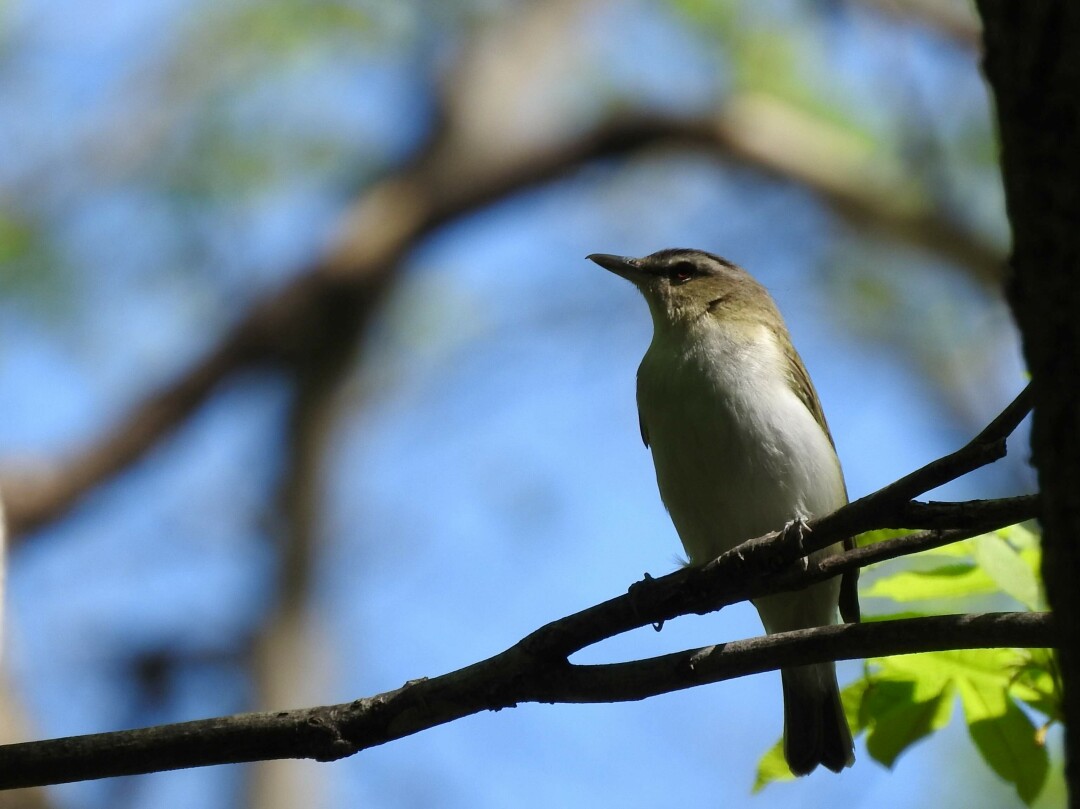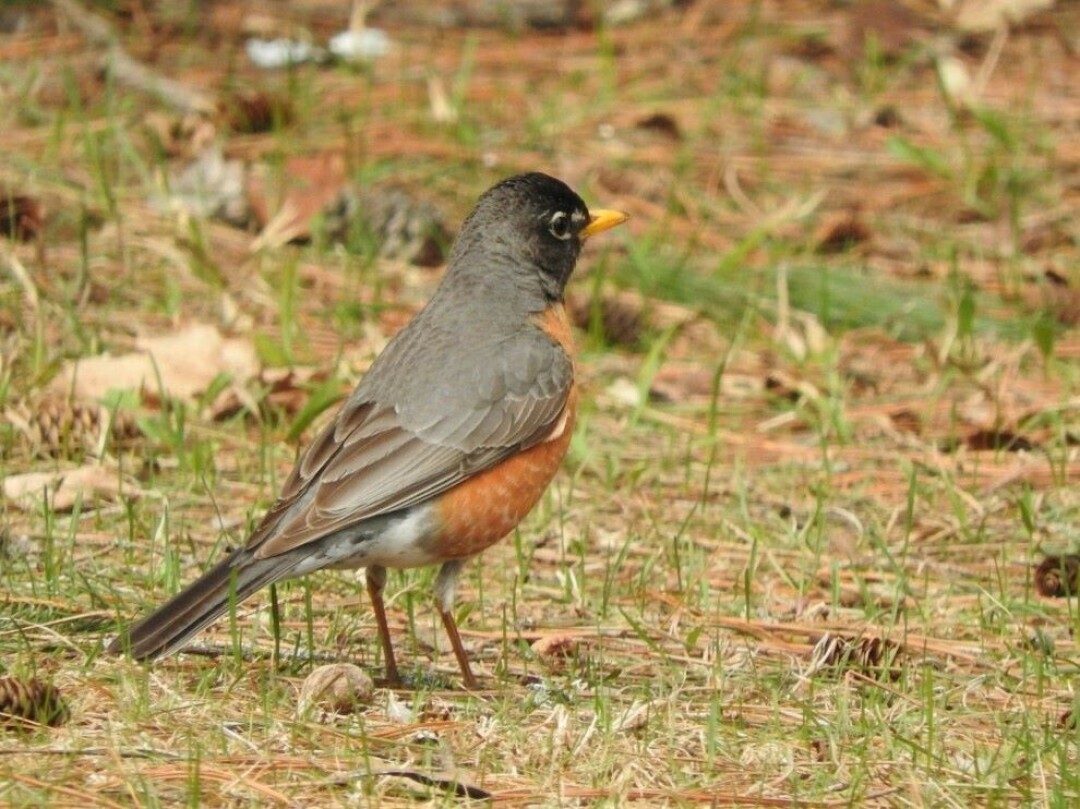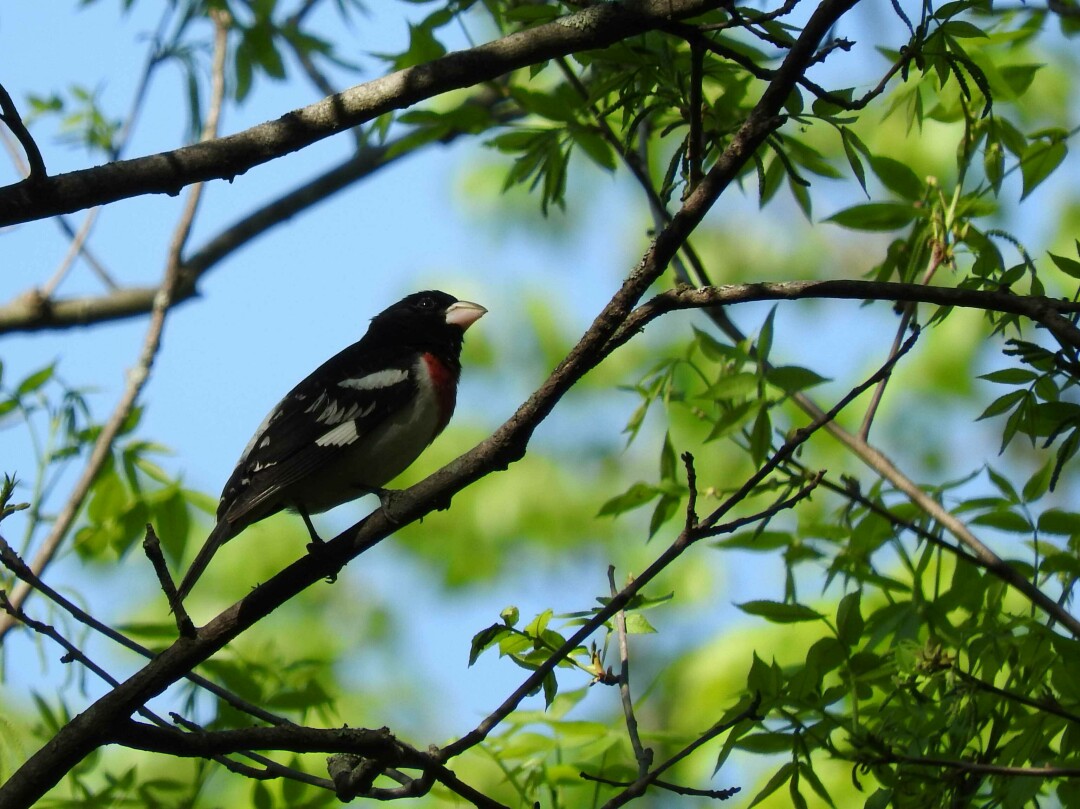Tuning up our ears for spring

Red-eyed vireos sing with a robin-like pattern, but with fewer breaks. One red-eyed vireo was recorded singing more than 20,000 phrases in a single day. (Photos by Emily Stone.)
Cheerily, cheer up, cheer up, cheerily, CHEER UP!
Nothing makes a person madder than being told to cheer up when they don’t want to, and yet the robin outside my window has been shouting at me to CHEER UP for weeks. I might appreciate the sentiment more if the admonitions didn’t start at the faintest hints of dawn light, long before my alarm goes off.
Once the alarm does go off and my morning routines are complete, I jump in my car to head to work. A second after the key turns, the singing begins again. Cheer up, cheerily…here I am…over here…in a tree.
This song is a little different than the robin’s. The rhythm within phrases is similar, but there’s more space between them, and they feel less like the bird is shouting.
In early spring, my car’s CD player is always occupied by “Who Cooks for Poor Sam Peabody?” a Bird Song Ear Training Guide by John Feith. It’s available on Spotify, too, if you’ve graduated from actual CDs. The name is a combination of two common bird song mnemonics – lyrics we put to bird songs to help us remember them.
Each spring as the northward migration takes flight, I use the CD to re-train my ears to identify the songs of the birds who have been away all winter.
The robins, bless their loud hearts, are pretty helpful with this, too. There are several birds whose songs are described in comparison to the robin’s.

American robins a loudmouths of early spring. Listening to their songs can help tune our ears to identifying other, less common species, too.
The red-eyed vireo, mentioned above, is slower than a robin’s frantic pace, but weaker, and not as squeaky. These small, olive-green birds are hard to spot in the treetops, but they sing more incessantly than any of their neighbors.
One red-eyed vireo sang 22,197 songs in a single day, as counted by naturalist Louise de Kiriline Lawrence in 1952.
Rose-breasted grosbeaks – those delightful gents with snappy black backs, white chests, and bright red cravats – are often said to sound like “a robin who has had singing lessons.” Their notes alternately rise and fall also, but the tone is sweeter and the songs longer.
And then there’s the burry voice of a scarlet tanager. The raspy phrases are usually described as a “robin with a sore throat,” but to my ear their whiskey voice is the sexiest of all the birds. Scarlet tanagers spend their time hidden high in the forest canopy and are almost impossible to see.
Their distinctive “chick-burr” call will interrupt my thoughts and automatically send me scanning the treetops for a glimpse of this handsome heartthrob.
Any birder will tell you that practice and repetition are key to identifying birds by their songs. The CD is helpful, but real birds are better. So, even though the robin outside my window thinks the Sun won’t rise if he gives me just one day to sleep in, I appreciate that he’s helping me tune up my ears for spring.
I just learned that the birds themselves tune up their ears in the spring.
Chickadees, writes Ed Young in his book An Immense World: How Animal Senses Reveal the Hidden Realms Around Us, change their forte in the fall. As winter approaches, chickadees need to be able to glean complicated information from their friends’ chick-a-dee calls in order to successfully navigate the social hierarchy in a big winter flock. Their hearing speeds up, and they are able to distinguish the fine structure of each other’s rapid-fire calls.
A chickadee’s spring is like the end of a party when couples start pairing up and sneaking into the woods – ladies’ choice. Male chickadees sing “fee-bee, fee-bay” sweetly and purely, and females judge his attractiveness based on how consistently he can sing these notes. Their ears’ focus switches from speed to pitch.
Nuthatches are the opposite. They hear faster in the spring, and are more sensitive to pitch in the fall.
The changes are driven by estrogen, which influences the length of the hair cells in their ears. In house sparrows, males don’t alter their hearing, but females make the same springtime shift from speed to pitch that chickadees do.
Well, the robin’s early morning shouting did nothing to cheer me up today, but learning something new about chickadees sure did! We’re all tuning up our ears for spring!
Emily Stone is Naturalist/Education Director at the Cable Natural History Museum. Emily’s award-winning second book, Natural Connections: Dreaming of an Elfin Skimmer, is now available to purchase at cablemuseum.org/books and at your local independent bookstore, too. For more than 50 years, the Cable Natural History Museum has served to connect you to the Northwoods. Our new exhibit: “The Northwoods ROCKS!” is open now! Our Summer Calendar of Events is ready for registration! Follow us on Facebook, Instagram, YouTube, and cablemuseum.org to see what we are up to.

Rose-breasted grosbeaks sound like robins “who have had singing lessons.”
